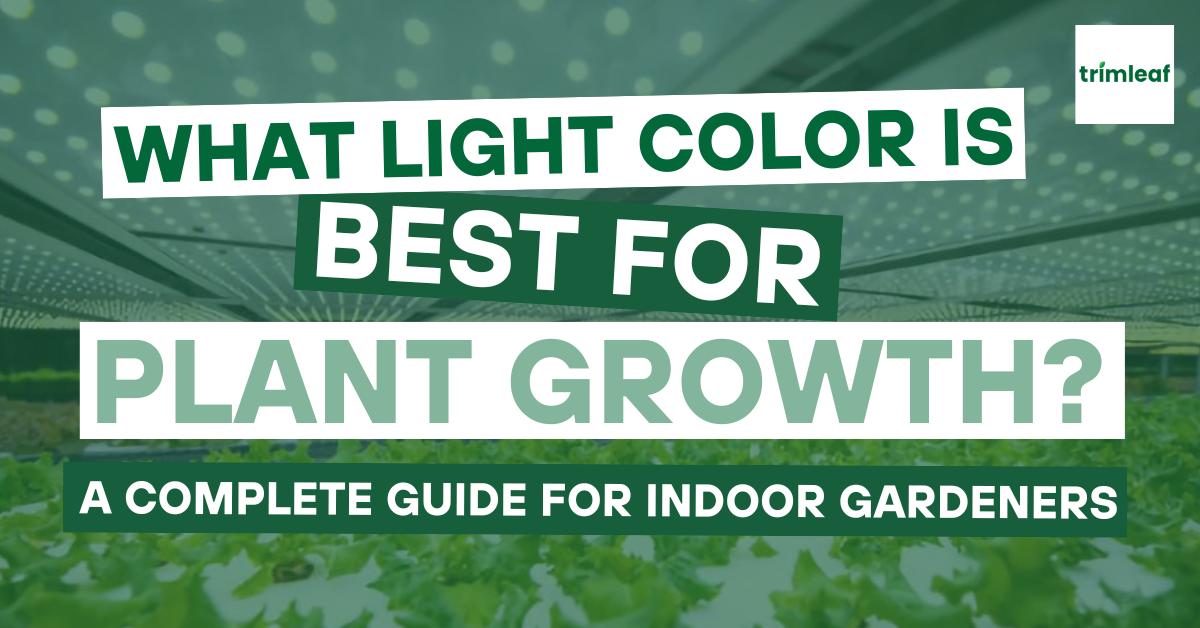
If you’ve been studying the light spectrum, especially for indoor growing, chances are, you’ve encountered different colors being mentioned.
Light colors in horticulture might give you a case of option paralysis, especially when you’re new to indoor growing. Truth be told, each light color will be crucial in plant growth, one way or the other.
Light in general is a key ingredient in overall plant health, as it fuels photosynthesis, which allows them to thrive.
Table of Contents
- Understanding Light Color and Plant Growth
- What is the Best Light Color for Growing Plants?
- Full-Spectrum Lights vs. Specific Color Lights
- Potential Downsides of Full Spectrum Grow Lights
- Optimizing Light Exposure: Distance and Duration for Indoor Plants
- Conclusion
- Frequently Asked Questions About Grow Light Color for Plant Growth
Understanding Light Color and Plant Growth
Before deciding which light color you need, we need to understand the light spectrum. The light spectrum our eyes see ranges from violet to red and corresponds to different wavelengths that these plants use for growing.
- Plants use chlorophyll, or the green pigment on leaves, to absorb light for photosynthesis.
- The light energy absorbed is used to convert carbon dioxide and water into glucose, which serves as plant food.
What is the Best Light Color for Growing Plants?

Every color in the light spectrum is important in plant development. That said, there isn’t a single best light color in plant development.
However, there is an ideal light color for certain stages of plant growth. Certain spectrums are more critical than the other, as they are needed for vegetation or flower development. You can say that each color has its time to shine.
Blue Light (450-490 nm)
Blue light is used in photosynthesis for healthy leaf and stem development. It is also used in phototropism, which allows plants to grow taller and regulate gas exchanges.
Blue light is best for the early stages of plant development, including seedling development. It is also ideal for growing leafy greens and herbs, such as lettuce and basil.
Red Light (620-750 nm)
Red light is used in photosynthesis, particularly for flowering and fruiting. It allows better blooming and fruit development.
If you’re growing plants like tomatoes, roses, root vegetables, and even cannabis, it’s essential to have red lighting.
Another variant of red is far red, which speeds up the flowering process, but should be used in moderation due to the risk of overheating.
UV Light
Ultraviolet light enhances plant resilience by promoting the production of secondary metabolites.
However, this light should be used in moderation, as too much ultraviolet light can harm plants.
Other Light Spectrums
- Green Light: Some say green light isn’t exactly efficient, but it helps maintain plant structure and can penetrate deeper into the canopy.
- Infrared Light (IR): IR isn’t visible to the naked eye, but helps in flowering and stem strength.
- Yellow Light: This light spectrum balances overall light exposure while supporting healthy chlorophyll production, in tandem with other spectrums.
Full-Spectrum Lights vs. Specific Color Lights

In finding which light color works best for your plants, most likely you’ve encountered full spectrum grow lights.
Full spectrum grow lights are designed to emulate natural sunlight, delivering a wide range of spectrums, including blue, red, UV, and IR. By having all these spectrums, you don’t need to choose between red or blue, as you get them in a single package.
These grow lights offer a lot of advantages, including versatility, and being able to work from seedling to flowering.
If natural sunlight is minimal, full-spectrum grow lights can provide the missing spectrums you need. They are also adjustable in the spectrum so you can balance the colors needed in the stage of plant growth.
Potential Downsides of Full Spectrum Grow Lights
Of course, full-spectrum grow lights have their share of weaknesses.
- They are more expensive and consume more power, compared to dedicated blue or red grow lights.
- They can be overkill when you’re only growing leafy plants.
That said, you should assess your needs when choosing between going for specific spectrums vs. full spectrum.
Optimizing Light Exposure: Distance and Duration for Indoor Plants
Now that you understand what light spectrum or colors work best for your plants, let’s look into proper light exposure.
Growing indoors needs optimal exposure to lights, and that includes distance and lighting schedule. You want the right distance to avoid elongated stems or light burns. On the other hand, you want the right amount of time to ensure that your plants use energy properly for growth.
Setting the Right Position for Grow Lights
Understanding the relationship between light intensity and distance will allow your plants to properly grow. If the lights are too low, your plants are likely to suffer from light burn. If the plants are stretching, then the lights are too high.
As a rule of thumb, consider the following:

- Seedling Stage: Position the lights around 18 - 24 inches away for low-wattage LED grow lights and increase the distance if the wattage is higher. You can set the light intensity to around 30 percent.
- Vegetative Stage: When the plants reach the vegetative stage, increase the distance to around 12- 20 inches. Like the seedling stage, increase the distance if the wattage is higher. You can also set the intensity to around 50 percent.
- Flowering or Fruiting Stage: In the last phase of plant growth, you can set the distance to around 8 - 16 inches and increase the distance for higher-wattage grow lights.
Adjusting Light Schedules for Each Growth Stage
Another important part of light exposure for plants is the light schedule. This allows for proper energy use for plants and allows plants to rest.
Just like having proper distance, light schedules have an ideal light schedule. As a rule of thumb, consider the following:
- Seedling Stage: Seedlings need long light exposure, so it’s best to expose them for 18 - 20 hours per day to help strengthen the roots during their early stages. It’s best to have a controller for this to ensure that your grow lights turn on and off at the right times.
- Vegetative Stage: When plants start developing their foliage, they would need around 16 - 18 hours of light exposure for leaf and stem development.
- Flowering and Fruiting Stage: When your plants start developing flowers or fruits, they will need around 12 - 14 hours of light exposure per day.
Conclusion
There’s no one-size-fits-all answer when it comes to what is the best light color for plants. Each spectrum plays a unique role in your plants’ development, and it’s all about finding the right balance to support growth. By understanding your plants’ needs and adjusting your light setup accordingly, you can create the perfect environment for a thriving indoor garden.
If you’ve decided on the direction of your indoor garden, check out our selection of high-quality grow lights, and be sure to consult our buyer's guide for the popular choices and tips on choosing the right light for your indoor garden.
Learn more about grow lights here:
- All About Grow Lights for Indoor Plants
- LED Grow Lights: A Comprehensive Buyer's Guide
- The Best 4x4 LED Grow Lights
- Best LED Grow Lights (2024)
- How Does the Grow Light Spectrum Influence Cannabis Growth?
- Grow Lights: How Many Watts Per Plant/Square Foot is Needed?
Frequently Asked Questions About Grow Light Color for Plant Growth
- What is the primary role of light in plant growth?
- Light is essential for photosynthesis, the process by which plants convert sunlight into energy.
- Why are different light colors important for plant development?
- Different light colors trigger specific physiological responses in plants. For example, blue light promotes vegetative growth, while red light stimulates flowering and fruiting.
- What are the benefits of using full-spectrum grow lights?
- Full-spectrum grow lights mimic natural sunlight, providing a balanced spectrum of light that supports all stages of plant growth. They are versatile and can be used for a variety of plants.
- How does the distance between the grow light and the plants affect growth?
- The distance between the light and the plants influences light intensity. If the lights are too close, plants may experience light burn. If they are too far, plants may not receive enough light for optimal growth.
- What is the ideal light schedule for seedlings?
- Seedlings typically require 18-20 hours of light per day to promote healthy root development.
- Can you use only blue or red light for plant growth?
- While blue and red light are essential for plant growth, using only one color can limit the plant's potential. A balanced spectrum of light, including other colors like green, yellow, and UV, is ideal for optimal growth.
- How does UV light benefit plants?
- UV light can enhance plant resilience by stimulating the production of secondary metabolites, which act as natural defenses against pests and diseases.
- What is the role of infrared light in plant growth?
- Infrared light, while invisible to the human eye, can help with flowering and stem strength.
- Can I use outdoor grow lights indoors?
- While it's possible to use outdoor grow lights indoors, it's important to consider factors such as light intensity, spectrum, and heat output. Indoor grow lights are specifically designed for indoor environments and often offer more precise control over light conditions.
- How often should I replace my grow lights?
- The lifespan of grow lights varies depending on the type and usage. LED grow lights typically have a longer lifespan than other types. However, it's important to monitor the light output over time and replace bulbs or fixtures as needed to maintain optimal plant growth.




